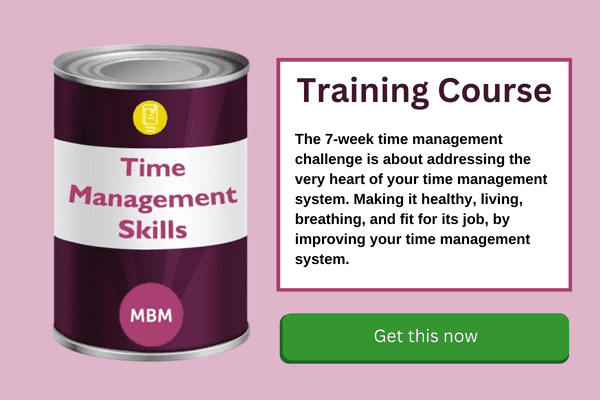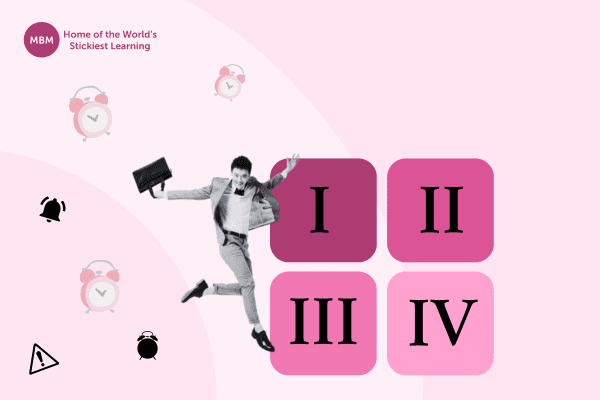Effective Prioritising Resource Every Leader Should Know and Use
Many of you may know the Urgent/Important quadrant. However, some struggle to understand how to use it effectively. Well, we’re here to help with all of that. In this article, we cover many key areas of Covey’s quadrants. First, we look at what the quadrants are all about. Next, we look at the benefits of using this time management tool. Also, we explain possible barriers to Covey’s quadrants in action.
Remember, time management is an essential skill for leaders to cultivate. This resource helps you achieve that goal when used correctly. However, you need to understand how to define your tasks into the quadrant effectively. Otherwise, you fall into the pitfall of assigning time and effort to tasks that fail to achieve your personal and business goals. Let’s take a closer look at the different aspects that make Covey’s quadrants a go-to resource in your toolkit.

What is Covey’s Quadrants?
Here, we need to give recognition to Covey taking his inspiration from Dwight D. Eisenhower, the 34th President of the United States of America. Eisenhower is famed for saying, in some version, one of the 2 following quotes :
What is important is seldom urgent and what is urgent is seldom important.”
and/or:
I have two kinds of problems: the urgent and important. The urgent are not important and the important are never urgent.”
He may in fact have said versions of both quotes, or they were simply misremembered or misquoted over the years. There is also mention that Eisenhower credits someone else completely for the concept that led to his principle. However, it cannot be denied that the principle was a useful force for Eisenhower’s efficiency and ability to achieve results as a famous general and later President of the USA.
Either way, Stephen Covey elaborated on this principle in his 1989 best-selling book “The 7 Habits of Highly Effective People.” Here, Covey’s quadrants further explain the necessity of using these areas to better manage your time and be more productive and efficient. The 4 quadrants Covey covers are:
- Urgent and Important
- Not Urgent but Important
- Urgent but not Important
- Not Urgent and Not Important
It’s great to know the headings of the quadrant, however, how do they actually work?
The 4 Quadrants in More Detail

This tool really is an easy one to use once we have a proper understanding of what it’s all about. However, confusion often occurs when we don’t properly identify the 4 sections of Covey’s quadrants and what should fit in where. When we make mistakes on this part of the process, we can cause ourselves more delays and assign ourselves less urgent tasks that don’t need our time and attention right away. Obviously, we want to avoid improper allocation of our tasks to get the best results.
In this section of the article, we look at each quadrant in more detail to better understand their meaning. By understanding Covey’s quadrants, we can use them more effectively.
Quadrant #1: Urgent and Important (Do It Now)
Here, we have the tasks that need immediate attention. In other words, they are at the top of your priority list and need you to take action NOW. Very often, we experience the most stress in this section of the quadrants. Here, we see:
- Emergencies and crises. (e.g. injury at work, sudden power failure, unexplained IT issue, etc.)
- End of deadlines.
- Major customer complaints.
- Serious staff issues (e.g. gross misconduct, physical assault, theft, etc.)
- All time-sensitive business objectives.
What we want to do is give top priority to these tasks and clear this area first. Where possible, we also want to keep certain tasks out of this box where possible. For example, completing tasks ahead of deadlines rather than leaving things until the last minute. The more time we spend in this section, the more stress we can experience.
Quadrant #2: Not Urgent but Important (Plan and Prepare)
Next in Covey’s quadrant, we have the area that allows for time and attention without the undue stress of quadrant #1. The tasks in this section need time and planning. Some examples include:
- Learning and development.
- Budgeting and strategic planning.
- Succession planning.
- Long-term goals.
- Relationship building.
This section focuses on the fact that all of these tasks are important, however, the sense of urgency is not there yet. When we leave these tasks unattended for too long, they can easily slip into quadrant #1 where you lose the time-comfort element and move to the tasks becoming time-sensitive.
From personal experience, I include Personal Development Plans for employees in this section. This is a task that needs proper planning and structure. Time frames should be set, respected and actioned. However, once deadlines for completing development plan steps start to pass by, more pressure is put on everyone involved to get back on track.
Another example is the departmental/team budget. We all have deadlines to complete and submit this annual task. However, many of us push this deadline as far as possible because, during the period, it’s not as urgent as other tasks at hand. We can avoid any type of report or task from slipping from quadrant #2 into the stressful quadrant #1 by giving time along the way to work through these tasks before the final deadline looms over us.
Click the image below for a larger version:

Quadrant #3: Urgent but not Important (Pass It On)
So, here we have the tasks that seem urgent to some but not important to others. In other words, they are time-sensitive but don’t contribute directly to your direct objectives and goals. One way to think of these tasks is time obligations, because, you are obliged to give some time to complete them. Here, we find tasks such as:
- Attending certain meetings. (Not all meetings we attend generate an effective use of our time.)
- Responding to non-urgent emails and calls.
- Interruptions during productive tasks.
- Spending time on fun tasks rather than required tasks.
- Completing tasks that should be delegated to others.
The main point we see here is that very often the tasks in this section are urgent and often important for others, however, they do not hold that same level of importance for us. Covey’s quadrants allow for certain approaches to each of the 4 quadrants, which we will cover later in the article.
Quadrant #4: Not Urgent and Not Important (Dump It Out)
So, in quadrant #4 we see the tasks that generate NO benefit to anyone involved. These are very much time wasters. They are not urgent and not important, yet, we still spend time on them. Some examples are:
- Certain emails and calls.
- Office place gossiping or storytelling.
- Pointless web-surfing (meaning it has nothing to do with your work tasks.)
Ideally, we would use only 3 quadrants. Getting rid of quadrant #4 completely would free up a lot of our time to give more focus and attention to the other 3 sections. However, we are all guilty, in some way, of spending at least some time in Q4, very often just for a short escape from the other 3 sections of focus.
How to Use Covey’s Quadrants in 5 Easy Steps

We now know the 4 sections of Covey’s quadrants. However, how can we get the best results using this useful tool? We have 5 easy steps to follow to be more efficient.
#1: Analyse All of Your Tasks, Including Deadlines
For Covey’s quadrants to work properly, we first need to know all of the tasks we need to assign for the period we are looking at. List all of the tasks you complete, no matter how big or small. During the analysis of the tasks, set time frames for each. The time frames can help with later steps for effective use of Covey’s quadrant.
#2: Identify The Level of Urgency and Importance for Each Task
So, you have your tasks and time frames. Now, identify the level of urgency and importance of each. This allows you to understand what to prioritise in terms of putting first things first. Without understanding what is urgent and important, the quadrant won’t work. Instead, you can end up with tasks in the wrong sections due to the lack of proper urgency and importance being allocated.
#3: Assign The Tasks Into the Quadrant
Next, assign the tasks to the different sections of Covey’s quadrant. Here, you select the tasks that match the headings from the quadrant. This gives you a visual aide to help with prioritising the tasks and understanding what to tackle when. This visual representation is a great benefit for many to keep focused on key tasks and objectives. Insert time frames next to the tasks to remind you.
#4: Learn to Let Go
Here, we avoid spending time on tasks that don’t generate results. This can be one of two ways. Either we delegate or we remove them entirely. That way, we have more time for tasks that really make an impact on our goals and objectives. However, letting go is easier said than done. Therefore, we need to do the following:
- Know what tasks we need to remove completely.
- Have effective delegation skills.
- Avoid holding on to tasks simply because you like them.
- Be ready to release control and give autonomy to others.
#5: Review Regularly and Reassign As Required
Finally, review the tasks on a regular basis. See where they currently sit in terms of their level of urgency and importance. As required, move the tasks into other quadrants. Here, you reassign them based on their new urgency and importance.
Benefits of Using Covey’s Quadrants

There are many benefits to using Covey’s quadrants. Here are some.
1- Increased Productivity
By using Covey’s quadrants, we are more productive. That is because we prioritise better. This skill is important so we avoid getting caught up in time-wasting tasks that distract us from our goals and objectives. Instead, use the quadrants to better understand where to focus your attention and efforts. It also tells us what to let go of, therefore, we have more time available to do other tasks.
2- Enhanced Delegation
We delegate more by using Covey’s quadrants. The reason is that the quadrant makes it very clear to us which tasks need to be handed over. Sometimes we simply don’t know what to delegate. Use the steps we mentioned above to complete the proper analysis and allocation of the tasks. Then, you will know what to delegate. Delegation brings many positives to a team once it is handled properly. As a leader, who delegates effectively, you:
- Show trust in others to take on the task.
- Create more skilled and knowledgeable team members.
- Allow others to take on greater responsibility and ownership of tasks.
- Prepare members of the team for more senior roles in advance.
- Ensure the team is more productive.
- Avoid overwhelming yourself or others on the team with too many tasks.
- Free up more time for yourself for Q2 tasks.
3- Reduced Stress
By using Covey’s quadrant, we can in fact reduce our stress levels. This is because we can better identify the tasks to keep out of quadrant 1 where most of our stress occurs. Instead, properly assign the tasks to avoid overloading quadrant #1 and, therefore, reducing the possibility of stressful tasks. Some people believe they work better under stress. However, in most cases, that’s not true. In fact, the more stress we experience, the better the chance that we will experience burnout.
4- Better Preparation
Ideally, we want to spend as much time as possible in quadrant 2 to achieve our goals and targets. However, that is not always the case due to a lack of planning and preparation.
A great example of using quadrant #2 to its fullest extent is fire fighters. They spend the majority of their time on tasks that feature in quadrant #2 which include training, strategising for different types of emergencies, etc. By doing this, they react better when the emergencies in quadrant #1 need their attention. We can all learn a lesson from that approach. As leaders, plan your long-term strategies better. Give more time and attention to developing and training your team for better results. Also, include succession planning so that you are ready when moves within the team need to be made.
Wrap Up

Before we end this particular article about Covey’s quadrant, let’s look at these last few points about this useful tool.
1. Don’t Underestimate the Importance of Proper Time Management
There are many time management tools out there. Have a look at other articles here on MBM for more information on what else you can do to improve your time management skills. What we would highlight here is the importance of having effective time management techniques that work for you.
2. Self-Discipline is Important for This Tool to Work
Even after we have done all of the important work to use the quadrant, we might still slip up. It can be easy to fall back into tasks in quadrants 3 and 4 that we are more comfortable with and that we like. Also, some of us have difficulty letting go and making the changes we need. This is where our level of self-discipline will really make a positive difference.
3. Remember to Use Quadrant #2 To The Max
This is really where you will get the best quality in terms of your business goals. By spending more time here, you avoid the stress of fire-fighting all the time (Q1) or wasting time on irrelevant tasks (Q3 & Q4).
From personal experience of using this tool for many years, I highly recommend that you spend time to understand Covey’s quadrants and start using it today. You will start seeing the results very quickly once you are using the tool correctly by following our easy 5 steps above.
Engage with us on LinkedIn.




